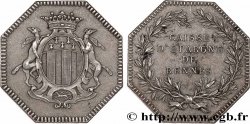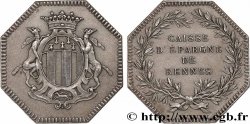fme_1069356 - LES CAISSES D'ÉPARGNE Médaille, 150 ans de la Caisse d’Épargne
90.00 €
Quantità
Aggiungi al carrello

Tipo : Médaille, 150 ans de la Caisse d’Épargne
Data: 1968
Nome della officina / città: Monnaie de Paris
Metallo : bronzo
Diametro : 67,5 mm
Asse di coniazione : 12 h.
Incisore JOLY Raymond (1911-2006)
Peso : 160,92 g.
Orlo : lisse + 1968 + Corne BRONZE
Marchio : corne BRONZE
Commenti sullo stato di conservazione:
Taches d’oxydation sur la tranche
Pedigree :
Collection JCT
Diritto
Titolatura diritto : 1818-1968 / CAISSE D’EPARGNE DE PARIS.
Descrittivo diritto : Fronton architectural de la banque.
Rovescio
Titolatura rovescio : ANÉPIGRAPHE.
Descrittivo rovescio : Ruche avec des abeilles autour.
Commento
Médaille conservée dans un écrin bordeaux.
En France, la Caisse d'épargne est une initiative privée du baron Joseph-Marie de Gérando, relayé par Benjamin Delessert et François de la Rochefoucauld-Liancourt, deux philanthropes, destinée à encourager l'épargne populaire dans une période marquée par des conditions économiques et sociales difficiles. La première ouverture d'une Caisse d'épargne a eu lieu à Paris le 22 mai 1818. Le livret va concrétiser l'acte d'épargne en permettant de conserver la trace des versements et intérêts perçus. La Caisse d'épargne ne rencontre pas un succès immédiat du fait de la faible capacité d'épargne des classes populaires, mais aussi d'une confiance trop faible envers l'institution. Les fondateurs demandent alors à l'État d'assurer les relais et de s'impliquer davantage. C'est ce qu'il fait en prenant en charge le placement et la garantie des fonds en fixant le plafond des livrets. La loi du 5 juin 1835 reconnaît alors les Caisses d'Épargne comme établissements privés d'utilité publique. Le succès du système s'amorce alors avec, 18 ans après la création du livret, un montant des dépôts qui atteint 147 millions de francs. Devant cette croissance, l'État, à travers la loi du 31 mars 1837, confie à la Caisse des Dépôts l'administration des fonds. En 1839, les Caisses d'épargne sont 284, puis 364 en 1847, 546 en 1895..
Medal preserved in a burgundy case.
In France, the Caisse d'épargne was a private initiative of Baron Joseph-Marie de Gérando, supported by Benjamin Delessert and François de la Rochefoucauld-Liancourt, two philanthropists, intended to encourage popular savings in a period marked by difficult economic and social conditions.. The first opening of a savings bank took place in Paris on May 22, 1818. The booklet will make the act of saving concrete by allowing you to keep track of the payments and interest received.. The Savings Bank did not meet with immediate success due to the low savings capacity of the working classes, but also to insufficient confidence in the institution.. The founders then asked the State to take over and become more involved.. This is what it does by taking charge of the placement and guarantee of funds by setting the ceiling of the booklets. The law of June 5, 1835 then recognized the Savings Banks as private establishments of public utility.. The success of the system then began with, 18 years after the creation of the booklet, an amount of deposits reaching 147 million francs. Faced with this growth, the State, through the law of March 31, 1837, entrusted the administration of the funds to the Caisse des Dépôts. In 1839, there were 284 savings banks, then 364 in 1847, 546 in 1895..
En France, la Caisse d'épargne est une initiative privée du baron Joseph-Marie de Gérando, relayé par Benjamin Delessert et François de la Rochefoucauld-Liancourt, deux philanthropes, destinée à encourager l'épargne populaire dans une période marquée par des conditions économiques et sociales difficiles. La première ouverture d'une Caisse d'épargne a eu lieu à Paris le 22 mai 1818. Le livret va concrétiser l'acte d'épargne en permettant de conserver la trace des versements et intérêts perçus. La Caisse d'épargne ne rencontre pas un succès immédiat du fait de la faible capacité d'épargne des classes populaires, mais aussi d'une confiance trop faible envers l'institution. Les fondateurs demandent alors à l'État d'assurer les relais et de s'impliquer davantage. C'est ce qu'il fait en prenant en charge le placement et la garantie des fonds en fixant le plafond des livrets. La loi du 5 juin 1835 reconnaît alors les Caisses d'Épargne comme établissements privés d'utilité publique. Le succès du système s'amorce alors avec, 18 ans après la création du livret, un montant des dépôts qui atteint 147 millions de francs. Devant cette croissance, l'État, à travers la loi du 31 mars 1837, confie à la Caisse des Dépôts l'administration des fonds. En 1839, les Caisses d'épargne sont 284, puis 364 en 1847, 546 en 1895..
Medal preserved in a burgundy case.
In France, the Caisse d'épargne was a private initiative of Baron Joseph-Marie de Gérando, supported by Benjamin Delessert and François de la Rochefoucauld-Liancourt, two philanthropists, intended to encourage popular savings in a period marked by difficult economic and social conditions.. The first opening of a savings bank took place in Paris on May 22, 1818. The booklet will make the act of saving concrete by allowing you to keep track of the payments and interest received.. The Savings Bank did not meet with immediate success due to the low savings capacity of the working classes, but also to insufficient confidence in the institution.. The founders then asked the State to take over and become more involved.. This is what it does by taking charge of the placement and guarantee of funds by setting the ceiling of the booklets. The law of June 5, 1835 then recognized the Savings Banks as private establishments of public utility.. The success of the system then began with, 18 years after the creation of the booklet, an amount of deposits reaching 147 million francs. Faced with this growth, the State, through the law of March 31, 1837, entrusted the administration of the funds to the Caisse des Dépôts. In 1839, there were 284 savings banks, then 364 in 1847, 546 in 1895..








 Segnalare un errore
Segnalare un errore Stampate la pagina
Stampate la pagina Condividi mia selezione
Condividi mia selezione Fai una domanda
Fai una domanda Consegnare / vendere
Consegnare / vendere
 Descrittivo
Descrittivo










